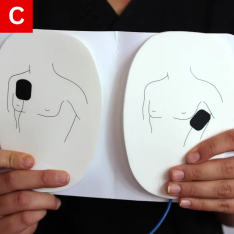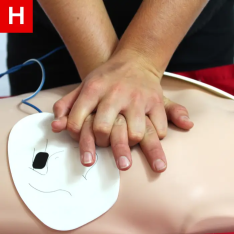- Use of Automated External Defibrillator (AED)
Use of Automated External Defibrillator (AED)
Ventricular fibrillation, caused by disorganized electrical activity in the main pumping chambers of the heart, is a common cause of cardiac arrest. The treatment for ventricular fibrillation is defibrillation or the delivery of an electric shock to the heart through the person’s chest wall. This shock attempts to stop the disorganized electrical activity and allow the heart’s normal rhythm to resume.
The automated external defibrillator (AED) is a device that recognizes ventricular fibrillation and other dysrhythmias and delivers an electric shock at the right time. The AED has become a common sight in public buildings. The AED is nearly foolproof and will not allow you to make a mistake. It is safe for anyone to use. In a witnessed cardiac arrest, where the person is observed to suddenly collapse, the most common cause is likely to be ventricular fibrillation and a defibrillator should analyze the person’s cardiac rhythm as soon as possible.
Using the team concept, one rescuer should coordinate all available rescuers so that one rescuer performs chest compressions while the second rescuer prepares the AED for use. Although there are many different brands of AEDs, all are utilized in a similar way. Be sure to move the person and yourself to a safe place before using the AED. Electricity and water can be lethal when combined. Ensure that the person is not wet (quickly wipe dry) or in close proximity to water before using the AED. It is safe to use an AED if the person is lying in the snow. If the person has an implanted device, such as a pacemaker, you will see a bulge over their chest. Place the defibrillator pads as close to the correct position as possible without being directly over the device. For persons with medication patches, remove the patch, wipe the skin dry, and apply the AED pad.








AED STEPS
- Retrieve the AED (Figure 8a).
- Open the case
- Turn on the AED
- Expose the person’s chest (Figure 8b).
- If wet, dry chest.
- Remove medication patches.
- Open the AED pads (Figure 8c).
- Peel off backing.
- Check for pacemaker or internal defibrillator
- Apply the pads (Figure 8d).
- Apply one pad on the upper right chest above the breast.
- Apply the second pad on the lower left chest below the armpit.
- Ensure the wires are attached to the AED box (Figure 8e).
- Move away from the person (Figure 8f).
- Stop CPR.
- Clear the person. Tell others not to touch the person.
- Let AED analyze the rhythm.
- If the AED message reads “Check Electrodes,” then:
- Ensure electrodes make good contact.
- If the chest is hairy, pull off the pad and replace it.
- If the AED message reads “Shock,”
- Be sure the person is “clear” by making sure no one is touching them.
- Press and hold the “shock” button until the AED delivers the shock (Figure 8g).
- Resume CPR for two minutes starting with chest compressions (Figure 8h).
- Repeat steps 1 to 10.
